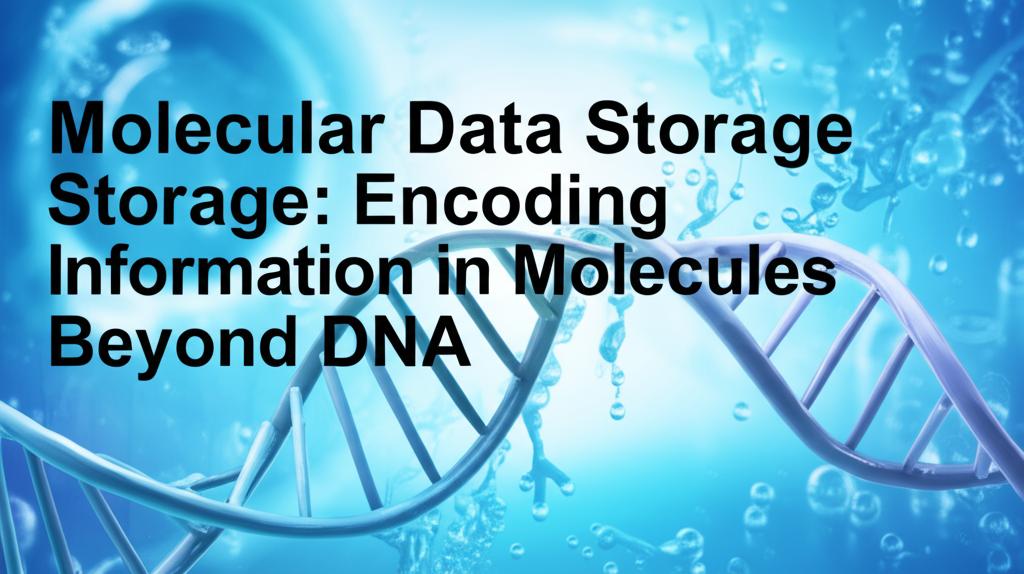The quest for denser, more durable, and energy-efficient data storage has propelled scientists to look beyond conventional silicon-based systems and even beyond the much-lauded DNA molecule. While DNA has captivated researchers with its incredible information density, the exploration into other molecular systems is unveiling a new frontier in data storage with unique advantages.
The Expanding Molecular Toolkit
Scientists are now investigating a diverse array of molecules, each with distinct properties that could overcome some of DNA's limitations or offer novel functionalities.
Synthetic Polymers: The Customizable ContendersDigital synthetic polymers are rapidly emerging as a powerful alternative. Unlike DNA's fixed four-base system, synthetic polymers can be tailor-made, allowing for a greater diversity of building blocks (monomers). This structural variety can translate to higher storage densities and enhanced stability. Researchers are designing these polymers to directly represent binary code, potentially simplifying encoding and decoding processes.
The ability to fine-tune the chemical and physical properties of synthetic polymers opens doors to increased durability and longevity compared to DNA. They can be engineered for greater resistance to environmental degradation, a crucial factor for long-term archival. Moreover, synthetic polymers can potentially store more data per unit of mass than DNA. Early research even suggests the possibility of storing a zettabyte of data—equivalent to 250 billion DVDs—in just ten grams of material using synthetic polymers.
The encoding process involves creating defined sequences of these monomers, and data is typically read out using techniques like mass spectrometry. While reading long polymer chains efficiently has been a challenge, new methods are being developed to overcome these limitations, even allowing for direct access to specific bits of information without sequencing the entire molecule. The potential for editing, erasing, encrypting, and repairing data encoded in synthetic polymers is also an active area of research.
Proteins: Nature's Versatile Building BlocksProteins, with their complex three-dimensional structures and diverse amino acid sequences, are also being explored for data storage and even neuromorphic computing. The unique mechanical, electronic, and optical properties of different proteins offer a rich landscape for innovation. Some proteins, like bacteriorhodopsin (a light-harvesting protein), have shown promise for optical data storage applications. The field of protein cryptography is also emerging, leveraging the diversity and unclonability of proteins to create highly secure data storage methods. While still in its early stages, protein-based storage could offer advantages in biocompatibility and even self-destruction of data after a certain number of incorrect access attempts.
Other Novel Molecular ApproachesBeyond long-chain polymers and proteins, researchers are investigating other unique molecular systems:
- Paramagnetic Molecules: Scientists have developed molecules incorporating rare-earth metal ions (lanthanides) whose paramagnetic properties allow them to act like tiny RFID chips. The information is encoded in the molecule's response to a magnetic field and can be read using nuclear magnetic resonance (NMR) without damaging the molecule. This method offers the potential for remote and repeatable data reading.
- Small-Molecule Mixtures: Another approach involves using mixtures of distinct small molecules, where the presence or absence of a particular molecule represents a bit of information. Mass spectrometry is then used to identify the components of the mixture and decode the stored data.
- Molecular Dyes: Researchers have demonstrated a method using commercially available dyes deposited by a specialized inkjet onto a surface. Different colors and combinations of dyes represent coded characters, which can be read by a fluorescence microscope. This technique offers stability, high density, and fast read/write speeds without complex molecular synthesis or sequencing.
Overcoming Challenges and Looking Ahead
Despite the exciting potential, molecular data storage beyond DNA faces several hurdles. The cost and speed of synthesizing and sequencing these novel molecules remain significant challenges. Ensuring data integrity and developing robust error correction methods are also crucial.
For synthetic polymers, while they offer customizable properties, scaling up synthesis in a cost-effective manner is a key focus. Automated synthesis platforms combining robotics and flow chemistry are being explored to reduce costs. Reading data efficiently, especially from very long polymer chains or complex mixtures, requires further advancements in analytical techniques like mass spectrometry.
Researchers are actively working on solutions to these challenges. Innovations in areas like epigenetic modifications on DNA, which use chemical markers rather than altering the DNA sequence itself, offer faster and more economical ways to encode data, potentially inspiring similar approaches in other molecular systems. The development of new algorithms and computational tools will also be essential for encoding, decoding, error correction, and managing vast amounts of molecularly stored data.
The journey into molecular data storage beyond DNA is just beginning. As scientists continue to unravel the potential of diverse molecular architectures, we can anticipate breakthroughs that will redefine the boundaries of information density, longevity, and even security. This expanding molecular toolkit promises a future where data is not just stored, but intricately woven into the very fabric of matter.

